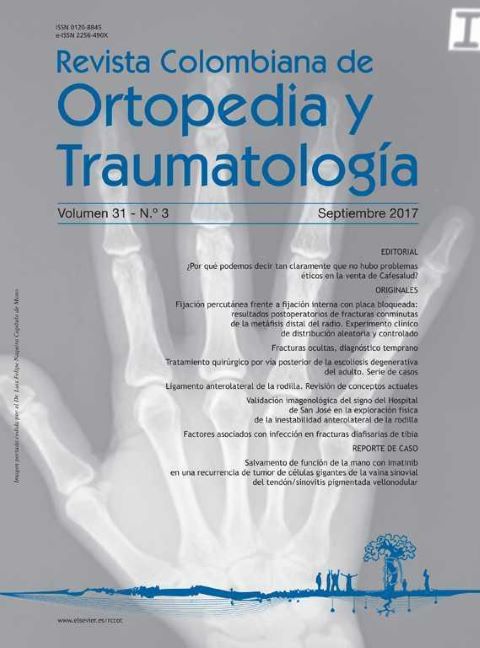Imaging validation of the San José Hospital sign in the physical examination of the antero-lateral instability of the knee
DOI:
https://doi.org/10.1016/j.rccot.2017.04.005Keywords:
instability, anterior cruciate ligament, pivot shift, MRIAbstract
Background: The clinical sign for instability of San José hospital is a variant of the pivot shift, described by the lead author, for the diagnosis of the anterior lateral instability of the knee. It is a clinical test, well tolerated by the patient that can be easily performed by an orthopaedic surgeon. The objective of this study was to determine the diagnostic validity of the San José Hospital sign on the physical examination to determine anteroposterior instability of the knee due to anterior cruciate ligament injury as compared to MRI as a reference standard.
Materials and methods: A study of the diagnostic tests performed on patients who attended a knee clinic and underwent the San José Hospital sign manoeuvre was conducted blindly and independently of the results of MRI. The sign was performed by orthopaedic surgeons with experience in knee surgery and with formal training to perform the manoeuvre.
Results: The study included 176 patients. The median age was 34.5 years (IQR: 26-51 years), and 63.1% were males. Magnetic resonance imaging showed that 88 patients had a rupture of anterior cruciate ligament. The Hospital of San José sign was positive for 80 patients. The sensitivity of the San José Hospital sign was 90.9% (95% CI: 82.9-96.0) and the specificity was 100% (95% CI: 95.9-100). The negative likelihood ratio (LR) was 0.1 (95% CI: 0.04-0.17).
Discussion: This manoeuvre is a valid clinical tool for the diagnosis of anteroposterior instability of the knee secondary to the anterior cruciate ligament injury, enabling the examination to be made with much less apprehension than when executed using the traditional manoeuvres.
Level of evidence: II.
Downloads
References
Insall JNSWN. Surgery of the knee Vol. 1. New York: Churchill Livingstone; 2001.
Beynnon BD, Johnson RJ, Abate JA, Fleming BC, Nichols CE. Treatment of anterior cruciate ligament injuries, part I. Am J Sports Med. 2005;33:1579-602. https://doi.org/10.1177/0363546505279913
Lunardini DJ, Hensler D, Illingworth KD, Musahl V. Single bundle anterior cruciate ligament reconstruction. Tech Knee Surg. 2011;10:108-15. https://doi.org/10.1097/BTK.0b013e31821cfc30
Lyman S, Koulouvaris P, Sherman S, Do H, Mandl LA, Marx RG. Epidemiology of anterior cruciate ligament reconstruction. J Bone Joint Surg Am. 2009;91:2321-8. https://doi.org/10.2106/JBJS.H.00539
Marongiu MS. The loss of extension test (LOE test): a new clinical sign for the anterior cruciate ligament insufficient knee J Orthopaed Traumatol. 2013;14:185-91. https://doi.org/10.1007/s10195-013-0238-y
Benjaminse A, Gokeler A, van der Schans CP. Clinical diagnosis of an anterior cruciate ligamentrupture: a meta-analysis. J Orthop Sports Phys Therap. 2006;36:267-88. https://doi.org/10.2519/jospt.2006.2011
Donaldson WF. A comparison of acute anterior cruciate ligament examinations initial versus examination under anesthesia. Am J Sport Med. 1985;13:5-10. https://doi.org/10.1177/036354658501300102
Jain DK, Amaravati R, Sharma G. Evaluation of the clinical signs of anterior cruciate ligament and meniscal injuries. Indian J Orthop. 2009;43:375-8. https://doi.org/10.4103/0019-5413.55466
Jonsson TAB. Clinical diagnosis of ruptures of the anterior cruciate ligament. Am J Sports Med. 1982;10:100-2. https://doi.org/10.1177/036354658201000207
Muñoz E, Mejía S, Correa J. Signo del Hospital de San José, una variante sencilla del pívot shift para diagnóstico de inestabilidad antero lateral de la rodilla por lesión del LCA. Rev Col Or Tra. 2014;28:13-5. https://doi.org/10.1016/S0120-8845(15)30004-3
Crawford R†. Magnetic resonance imaging versus arthroscopy in the diagnosis of knee pathology, concentrating on meniscal lesions and ACL tears: a systematic review. Br Med Bull. 2007;84:5-23. https://doi.org/10.1093/bmb/ldm022
Downloads
Published
How to Cite
Issue
Section
License
Copyright (c) 2024 Revista Colombiana de ortopedia y traumatología

This work is licensed under a Creative Commons Attribution 3.0 Unported License.




